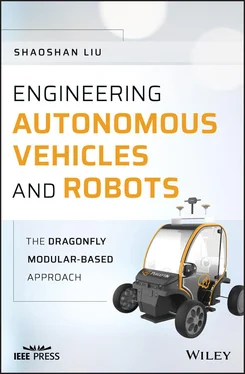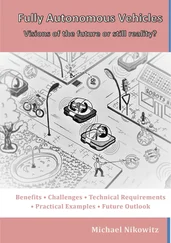3 2 In-Vehicle Communication Systems2.1 Introduction 2.2 CAN 2.3 FlexRay 2.4 CANopen References
4 3 Chassis Technologies for Autonomous Robots and Vehicles3.1 Introduction 3.2 Throttle-by-Wire 3.3 Brake-by-Wire 3.4 Steer-by-Wire 3.5 Open Source Car Control 3.6 OpenCaret 3.7 PerceptIn Chassis Software Adaptation Layer References
5 4 Passive Perception with Sonar and Millimeter Wave Radar4.1 Introduction 4.2 The Fundamentals of mmWave Radar 4.3 mmWave Radar Deployment 4.4 Sonar Deployment References
6 5 Localization with Real-Time Kinematic Global Navigation Satellite System5.1 Introduction 5.2 GNSS Technology Overview 5.3 RTK GNSS 5.4 RTK-GNSS NtripCaster Setup Steps 5.5 Setting Up NtripServer and NtripClient on Raspberry Pi 5.6 Setting Up a Base Station and a GNSS Rover 5.7 FreeWave Radio Basic Configuration References
7 6 Computer Vision for Perception and Localization6.1 Introduction 6.2 Building Computer Vision Hardware 6.3 Calibration 6.4 Localization with Computer Vision 6.5 Perception with Computer Vision 6.6 The DragonFly Computer Vision Module References
8 7 Planning and Control7.1 Introduction 7.2 Route Planning 7.3 Behavioral Planning 7.4 Motion Planning 7.5 Feedback Control 7.6 Iterative EM Plannning System in Apollo 7.7 PerceptIn's Planning and Control Framework References
9 8 Mapping8.1 Introduction 8.2 Digital Maps 8.3 High-Definition Maps 8.4 PerceptIn's π-Map References
10 9 Building the DragonFly Pod and Bus9.1 Introduction 9.2 Chassis Hardware Specifications 9.3 Sensor Configurations 9.4 Software Architecture 9.5 Mechanism 9.6 Data Structures 9.7 User Interface References
11 10 Enabling Commercial Autonomous Space Robotic Explorers10.1 Introduction 10.2 Destination Mars 10.3 Mars Explorer Autonomy 10.4 Challenge: Onboard Computing Capability 10.5 Conclusion References
12 11 Edge Computing for Autonomous Vehicles11.1 Introduction 11.2 Benchmarks 11.3 Computing System Architectures 11.4 Runtime 11.5 Middleware 11.6 Case Studies References
13 12 Innovations on the Vehicle-to-Everything Infrastructure12.1 Introduction 12.2 Evolution of V2X Technology 12.3 Cooperative Autonomous Driving 12.4 Challenges References
14 13 Vehicular Edge Security13.1 Introduction 13.2 Sensor Security 13.3 Operating System Security 13.4 Control System Security 13.5 V2X Security 13.6 Security for Edge Computing References
15 Index
16 End User License Agreement
1 Chapter 2 Table 2.1 Comparisons between CAN and FlexRay.
2 Chapter 9Table 9.1 DragonFly Pod chassis specification.Table 9.2 DragonFly bus chassis specification.
3 Chapter 12Table 12.1 Summary of V2X solutions for autonomous driving.
4 Chapter 13Table 13.1 Summary of security threats.
1 Chapter 1 Figure 1.1 Cost breakdown of existing autonomous driving solutions. Figure 1.2 Modular design of a DragonFly Pod. Figure 1.3 Modular design architecture.
2 Chapter 2 Figure 2.1 Modular design architecture. Figure 2.2 CAN protocol layers. Figure 2.3 CAN message format. Figure 2.4 Flowchart of a typical CANopenNode implementation.
3 Chapter 3 Figure 3.1 Modular design architecture. Figure 3.2 Electronic throttle control.Figure 3.3 Kia Soul drive-by-wire steering.Figure 3.4 PerceptIn chassis interface.Figure 3.5 CAN bus connection setup.Figure 3.6 DragonFly Pod software interface.
4 Chapter 4Figure 4.1 Modular design architecture.Figure 4.2 FMCW radar block diagram: 1, synthesizer; 2, TX antenna; 3, RX an...Figure 4.3 Sample configuration of mmWave radar.Figure 4.4 Detection range of mmWave radar.Figure 4.5 Hardware set.Figure 4.6 Radar detection UI.Figure 4.7 Radar hardware specifications.Figure 4.8 Sample configuration of sonar.Figure 4.9 Detection range of sonar.Figure 4.10 Hardware set.Figure 4.11 Sonar detection UI.Figure 4.12 Sonar sensor specifications.
5 Chapter 5Figure 5.1 Modular design architecture.Figure 5.2 RTK GNSS.Figure 5.3 RTK GNSS architecture.Figure 5.4 GPS antenna installation requirements.Figure 5.5 Raspberry Pi setup.Figure 5.6 SD card setup.Figure 5.7 Connecting Raspberry Pi to the GNSS station.Figure 5.8 Setting up the base station.Figure 5.9 Components: 1, antenna; 2, GNSS receiver module; 3, power supply ...Figure 5.10 Setup steps.Figure 5.11 Connection to PC.Figure 5.12 Placement of a GNSS base station antenna.Figure 5.13 Device setup interface.Figure 5.14 Input of the freset command.Figure 5.15 Freset command successful.Figure 5.16 “gpgga com1 1” command successful.Figure 5.17 “mode base time 60 1.5 2.5” command successful.Figure 5.18 GPGGA fix status.Figure 5.19 Rover hardware setup.Figure 5.20 Rover hardware components: 1, GNSS antenna; 2, GNSS receiver mod...Figure 5.21 Rover station antenna installation.Figure 5.22 Cable connection.Figure 5.23 Connecting the GNSS module.Figure 5.24 Rover station output on the screen.Figure 5.25 RTK-GNSS data transmission scheme by FreeWave radio.Figure 5.26 900 MHz or 2.4 GHz radio programming screen on CoolTerm.Figure 5.27 900 MHz or 2.4 GHz radio programming screen on GtkTerm.Figure 5.28 LED configuration.
6 Chapter 6Figure 6.1 Modular design architecture.Figure 6.2 Seven layers of technologies to build computer vision hardware.Figure 6.3 Synchronization.Figure 6.4 Aprilgrid.Figure 6.5 DragonFly sensor module.Figure 6.6 DragonFly+ hardware architecture.
7 Chapter 7Figure 7.1 Modular design architecture.Figure 7.2 Planning and control module architecture.Figure 7.3 Weighted graph data structure.Figure 7.4 Dijkstra's algorithm pseudocode.Figure 7.5 A* algorithm pseudocode.Figure 7.6 Value iteration algorithm pseudocode.Figure 7.7 Example of a POMDP.Figure 7.8 RRT algorithm illustration.Figure 7.9 RRT algorithm pseudocode.Figure 7.10 RRT* algorithm pseudocode.Figure 7.11 Feedback control.Figure 7.12 A PID controller.Figure 7.13 PID pseudocode.Figure 7.14 Model predictive control.Figure 7.15 Path and trajectory definition.Figure 7.16 ST-graph example.Figure 7.17 Modules in the Iterative EM planning.Figure 7.18 DP-based path planning in the Iterative EM planning algorithm.Figure 7.19 DP path and speed computation results are interpreted as decisio...Figure 7.20 PerceptIn's planning and control framework.
8 Chapter 8Figure 8.1 Modular design architecture.Figure 8.2 OSM architecture.Figure 8.3 JOSM user interface.Figure 8.4 Adding a tag in JOSM.Figure 8.5 HD map creation.Figure 8.6 Example of our map's topology.Figure 8.7 The Anteater Recreation Center. The solid line is the lane map th...Figure 8.8 The resulting map in the JOSM.
9 Chapter 9Figure 9.1 DragonFly two-seater pod.Figure 9.2 DragonFly eight-seater bus.Figure 9.3 DragonFly two-seater pod sensor configuration.Figure 9.4 DragonFly eight-seater bus sensor configuration.Figure 9.5 DragonFly system software architecture.Figure 9.6 DragonFly system mechanism.Figure 9.7 DragonFly UI when the vehicle is static.Figure 9.8 DragonFly UI when the vehicle is moving.
10 Chapter 10Figure 10.1 The future of commercial space exploration.Figure 10.2 Grid-based traversability map.Figure 10.3 Mars 2020 explorer.Figure 10.4 Mars navigation map generation.
11 Chapter 12Figure 12.1 V2X communications in crossroads.
1 Cover
2 Table of Contents
3 Begin Reading
1 iii
2 iv
3 1
4 2
5 3
6 4
7 5
8 6
9 7
10 8
11 9
12 10
13 11
14 12
15 13
16 14
17 15
18 16
19 17
20 18
21 19
22 20
23 21
24 22
25 23
26 24
27 25
28 26
29 27
30 28
31 29
32 30
33 31
34 32
35 33
36 34
37 35
38 36
39 37
40 38
41 39
42 40
43 41
Читать дальше











